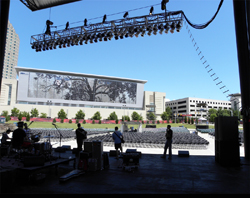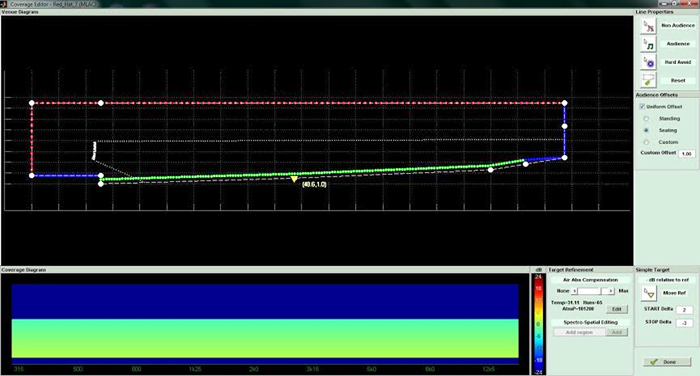
RMB measured the environment with the aid of laser distance finders equipped with inclinometers. Once the area’s distances and elevations were mapped, calculations were made to determine the configuration of the PA hangs in accordance with established performance goals.
“Based upon our measurements, we obtained a clear picture of the degrees of tilt we’d need in the multi-cellular arrays we chose for this application,” Cannady recalls. “We took everything into consideration before installing the PA. Where the audience starts, the rise of the ground, and the furthest point where we wanted to stop the sound were among the criteria considered. We referred to the areas where we wanted to stop the sound as ‘hard avoids.’
He adds, “The stage was a hard avoid, and just as we were ultimately very successful in keeping sound out of the surrounding neighborhoods, there was no sound from the PA escaping onto the stage either.
“When we were done, it was actually quite an unnerving experience standing onstage during a performance, because everything was so deadly still. With a band using in ear monitors, there was simply no sound up there at all. It was like watching a mime troupe perform. Step out into the audience, however, and it was a totally different experience.”
Design Template
Central to RMB’s accomplishments at Red Hat was the Martin Audio algorithm-driven Display2 software package managing the MLA Compact arrays heading up the main system. Under this mindful guidance, each cabinet had dedicated amplification for the components inside as well as its own dataset DSP.
Within this design template, every component was configured to act in a fashion that provided prescribed levels of sound for certain areas, while simultaneously creating phasing that took it out in others.

“What we were able to do,” Cannady says, illustrating the finer points of the RMB design, “was effectively push the PA at 95 dB(C) across one area, drop it off 12-15 dB in the next 10 to 15 feet, and then stop it completely where we wanted our coverage to end. When you reached the latter point, it was almost as if you had walked into another room.”
RMB deployed 24 Martin Audio MLA Compact enclosures, flown 12 per side at the Red Hat stage, to meet the needs of its PA blueprint. Built expressly to meet the demands of applications like this with levels of precision control needed for the prescribed hard cut-off areas and suppression of sound spilling into neighboring areas, MLA (Multi-cellular Loudspeaker Array) technology places the audience first in its approach, in this case offering RMB the ability to specify exacting measures of SPL and frequency response at points throughout the venue.
